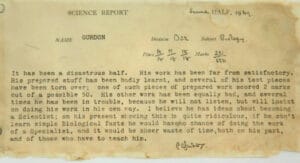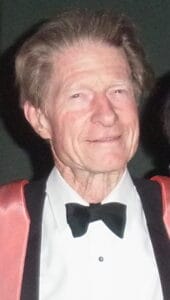Gurdon was born in Dippenhall, a rural hamlet in Surrey, England, which even today only has around 150 residents. The family moved to nearby Frensham, perhaps to be closer to schools. As a teen, Gurdon’s school was Eton College, where he studied biology. He didn’t do particularly well. At 15, his “half” report (semester report card) from his biology teacher didn’t hold out much hope for young John’s interest in science: “It has been a disastrous half” for Gurdon, it began, with one assignment scoring “2 marks out of a possible 50.” Worse, the teacher said, he “will insist on doing his work his own way,” and his “ideas about becoming a Scientist” are “quite ridiculous.” He was ranked last in his class of 250.

Gurdon was so amused by the report he had it framed — the only thing he ever had framed in his life. He still headed to Oxford to study the Classics, but a “mixup” in the registrar’s office put him on track to study zoology. He stayed at Oxford through his Doctorate in Zoology in 1960, then moved to the California Institute of Technology for postdoctoral studies. Once that was complete, he returned to England to teach at Oxford. But he spent most of his career at the Medical Research Council’s Laboratory of Molecular Biology. His “insistence on doing his work his own way” proved useful.
At the time he was studying at Oxford, it was thought that when a fertilized egg divides and forms new cells, and those cells “differentiate” to become organs, bones, and other structures, they would lose the information they had early on — the non-specialization abilities of stem cells. Gurdon thought this had to be incorrect, and sought to prove his theory with techniques he learned in getting his doctorate. In 1962, he isolated a fertilized frog’s egg and removed its nucleus. It then had no chance to develop into a tadpole, let alone a frog. He then removed the nucleus from a single intestinal cell of a tadpole and transferred it into the egg. If his theory was correct, that egg would regain the ability to grow into a tadpole — and then a frog. It did.
The technique, because it involved cell nuclei, was called “nuclear transplantation,” which was first demonstrated by Robert Briggs and Thomas King at the Lankenau Hospital Research Institute in Philadelphia in 1952. It was Gurdon who, a decade later, proved the full potential of the technique. His work showed definitively that the nucleus of a mature, specialized cell retains the complete genetic blueprint to form an entire organism — an insight that laid the foundation for stem cell research. Except few scientists believed his results as they were counter to the prevailing wisdom, and his brilliant conclusion was largely ignored for a decade. Gurdon rechecked his work, and pushed on as he could, realizing that microinjected messenger RNA molecules could be used to identify the proteins they encoded, helping study gene function.
Also in 1962, Shinya Yamanaka was born in Japan. He grew up to be a surgeon, but had difficulty with his first real patient — a friend — taking more than an hour to do a 10-minute surgery. Colleagues called him “Jamanaka” — a pun on the Japanese word for “obstacle.” Rather than continue as a practicing doctor, Yamanaka went into research, hoping to clarify the characteristics of embryonic stem cells. That goal led to a position at the Nara Institute of Science and Technology. By then, Gurdon’s work was well established as a breakthrough, and in 1989 he was a founding member of the Wellcome/CRC Institute for Cell Biology and Cancer — which later was renamed the Gurdon Institute.
In 2006, Yamanaka was seeking to expand on Gurdon’s work, and he and his team successfully generated induced pluripotent stem cells using cells from adult mice. Gurdon explained the progress this way. At the time of his own work proving that differentiation doesn’t mean cells lose their stem-like qualities, “I don’t think anyone could have foreseen the relevance of nuclear transplantation to current ideas of cell replacement. The original aim of these experiments was to determine whether or not the genome remained constant in all cell types. The possibility of deriving one cell type from another clearly existed. But two key advances were necessary for this to become a reality in humans. One was that embryonic stem cells needed to be able to proliferate indefinitely without the usual accompanying process of progressive differentiation that takes place in normal development” — his original research. “The other key advance is that of Shinya Yamanaka with his discovery of iPS cells, obviating the need to obtain human eggs.”

In 2009, Gurdon and Yamanaka were awarded the Albert Lasker Basic Medical Research Award for “discoveries have opened potential avenues toward personalized cell-replacement therapies. Such treatments might offer a means to restore malfunctioning or worn out tissues without subjecting a patient to the risks of immune rejection. Reprogrammed cells also afford novel approaches toward understanding currently inscrutable diseases and for screening drugs to thwart these conditions. Moreover, because scientists can create reprogrammed cells from adult tissue, the technologies come without the controversy that accompanies methods based on embryonic stem cells.” In 2012, Gurdon and Yamanaka shared the Nobel Prize in Physiology or Medicine for the same reasons.
The importance of Gurdon’s fundamental work can’t be overstated. He had shown that the genetic information in a mature, specialized cell is still complete — the nucleus can be “reset” if placed in the right environment (an enucleated egg). This helps in the basic understanding of how stem cells work, but also more in being able to create patient-specific stem cells for studying and, eventually, treating diseases and creating new drugs to cure them, all without using stem cells from embryos. That groundwork underpins today’s regenerative medicine, offering the prospect of repairing or replacing damaged tissues using a person’s own reprogrammed cells.
Today’s researchers are standing on the shoulders of these giants, with a “failed” 15-year-old student of biology at the base of the pillar. Sir John Bertrand Gurdon died on October 7, at 92.
(Yamanaka, at only 63, continues as a professor and the director emeritus of the Center for iPS Cell Research and Application at Kyoto University.)
